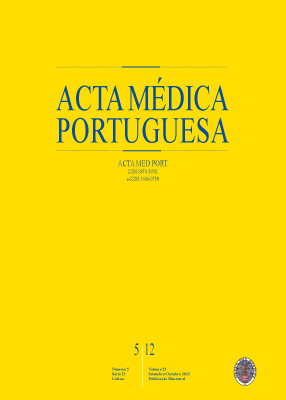Mucosectomia Endoscópica de Neoplasias Superficiais do Cólon e Recto: Análise de 140 Procedimentos
DOI:
https://doi.org/10.20344/amp.287Resumo
Introdução e Objectivos: A mucosectomia endoscópica (ME) tem mostrado ser útil na ressecção de grandes lesões colorrectais sésseis e planas, evitando a necessidade de intervenção cirúrgica. O objectivo deste estudo foi avaliar a eficácia e segurança da ME em lesões colorrectais usando a técnica de injecção e corte.
Material e Métodos: Com base na análise dos relatórios de colonoscopia, realizadas entre Fevereiro de 2007 e Fevereiro de 2010, seleccionaram-se as lesões ressecadas ≥ 10 mm de diâmetro, registando-se as suas características endoscópicas e histológicas, complicações, vigilânica e necessidade cirúrgica.
Resultados: Durante o período em estudo foram realizados 140 MEs em 133 doentes (82 homens; idade média de 64,4 ± 12,4 anos). A dimensão média das lesões ressecadas foi de 18,5 ± 8,5 mm, tendo a maioria localização proximal ao ângulo hepático (47,8%). A classificação da sua morfologia endoscópica foi: Is-60; IIa-54; IIb-14; IIa+IIc-12. Em 56,4% dos casos a ressecção foi efectuada num fragmento. As lesões > 20mm foram ressecadas, mais frequentemente, em dois ou mais fragmentos (OR: 13,7; 95% CI: 3,8-49,6; p < 0,0001). A ressecção endoscópica foi considerada completa em 91,4% dos casos. Histologicamente classificaram-se em: alterações inespecíficas-1; pólipo hiperplásico-8; adenoma-124, adenocarcinoma-7. Verificaram-se complicações em 5,7% dos casos (6 hemorragia intra-procedimento; 1 hemorragia tardia; 1 perfuração). Realizaram-se 144 colonoscopias de vigilância em 90 doentes. Verificou-se recorrência local em 17/90 (18,9%), 10 dos quais tratados com nova ME. A taxa de recorrência não foi afectada pela dimensão da lesão, localização e tipo de ressecção. Foram referenciados para cirurgia 21 doentes (15%), na maioria, por ressecção incompleta da lesão inicial.
Conclusão: A ME mostrou-se eficaz e segura no tratamento de lesões colorrectais sésseis e planas. Em lesões maiores que 20mm a técnica utilizada associou-se com frequência a ressecções em mais de um fragmento, que não determinaram uma taxa de recorrência mais elevada. A ME foi exequível na ressecção das recorrências locais.
Downloads
Downloads
Publicado
Como Citar
Edição
Secção
Licença
Todos os artigos publicados na AMP são de acesso aberto e cumprem os requisitos das agências de financiamento ou instituições académicas. Relativamente à utilização por terceiros a AMP rege-se pelos termos da licença Creative Commons ‘Atribuição – Uso Não-Comercial – (CC-BY-NC)’.
É da responsabilidade do autor obter permissão para reproduzir figuras, tabelas, etc., de outras publicações. Após a aceitação de um artigo, os autores serão convidados a preencher uma “Declaração de Responsabilidade Autoral e Partilha de Direitos de Autor “(http://www.actamedicaportuguesa.com/info/AMP-NormasPublicacao.pdf) e a “Declaração de Potenciais Conflitos de Interesse” (http://www.icmje.org/conflicts-of-interest) do ICMJE. Será enviado um e-mail ao autor correspondente, confirmando a receção do manuscrito.
Após a publicação, os autores ficam autorizados a disponibilizar os seus artigos em repositórios das suas instituições de origem, desde que mencionem sempre onde foram publicados e de acordo com a licença Creative Commons









